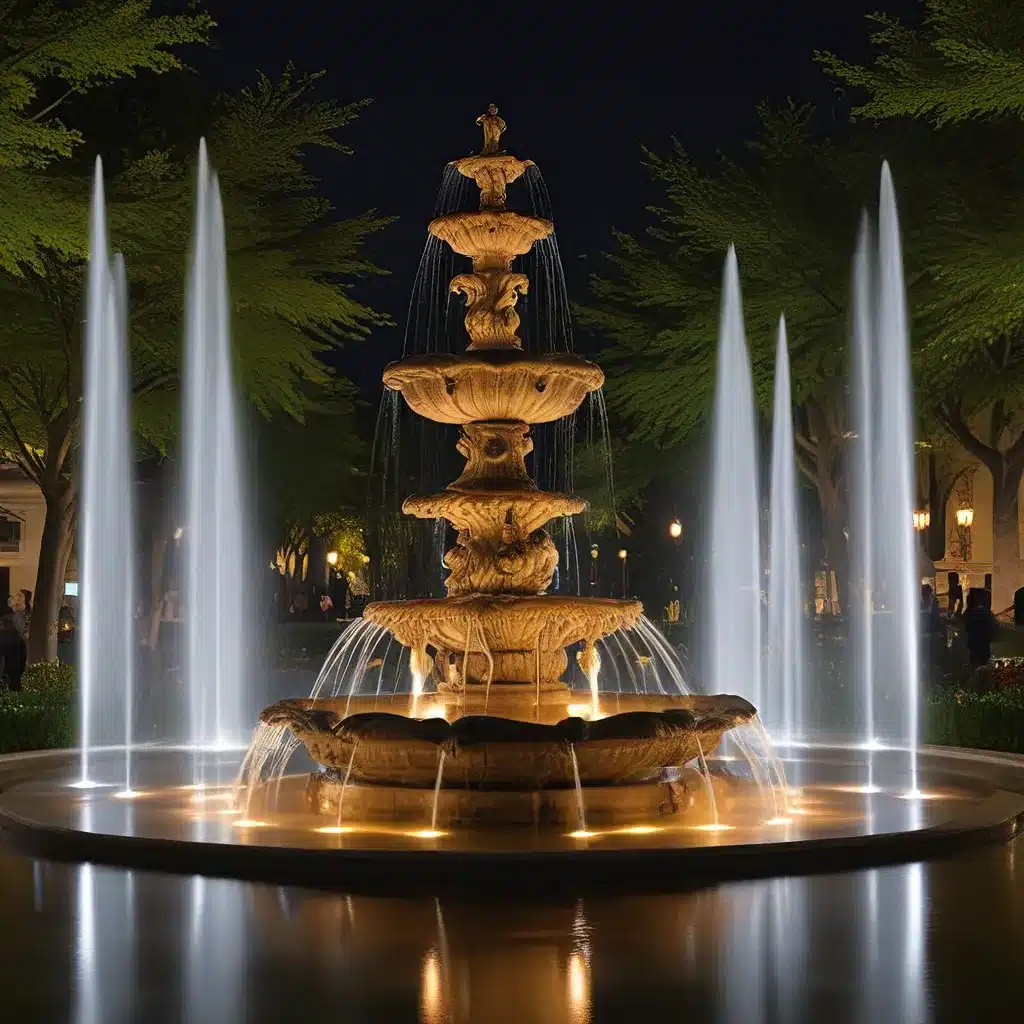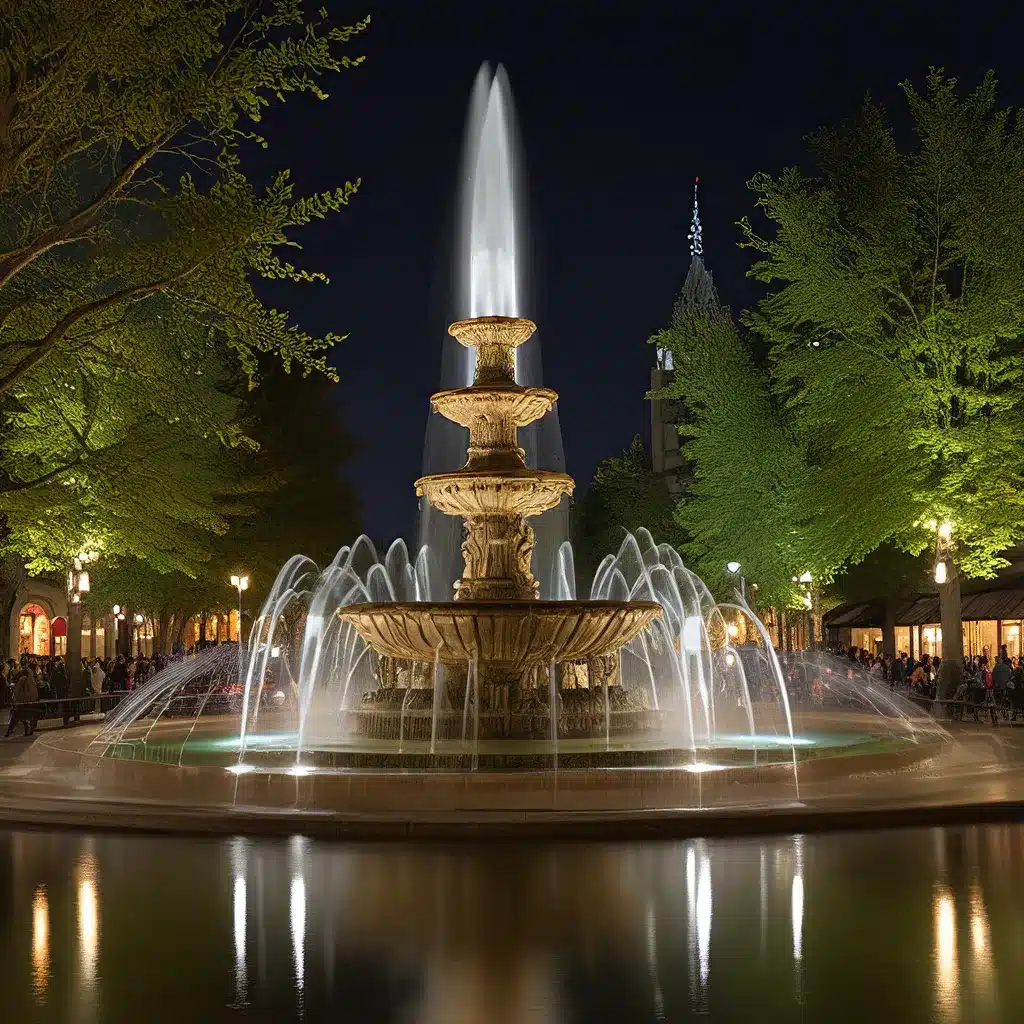
Fountain Design Essentials – Welcome to Fountain Lights
Menu
Fountain Design Essentials – Welcome to Fountain Lights

Ah, the humble fountain – a seemingly simple yet mesmerizing feature that can completely transform any outdoor space. But have you ever wondered what truly goes into creating those breathtaking, illuminated fountain displays that leave us in awe? As someone who’s always been fascinated by the interplay of water, light, and architecture, I’m excited to share the insider secrets of fountain illumination with you.
Let’s start by delving into the science behind these captivating water features. At their core, fountains rely on a carefully orchestrated dance between water and light to create their mesmerizing effects. The way the water is pumped, shaped, and directed plays a crucial role in how it interacts with the lighting system.
One of the key factors is the water pressure and flow rate. By precisely controlling these elements, fountain designers can create a wide range of effects, from delicate, mist-like sprays to towering, dramatic plumes. Higher water pressure generally leads to more forceful, vertical jets, while lower pressure results in gentler, more dispersed patterns.
But the real magic happens when you introduce lighting into the equation. LED lights have revolutionized the fountain industry, offering a level of control and versatility that was simply unimaginable just a few decades ago. These energy-efficient bulbs can be precisely positioned and programmed to illuminate the water in countless ways, from subtle washes of color to dynamic, pulsing displays.
Fountain lighting kits often incorporate features like color-changing capabilities and synchronized lighting sequences, allowing designers to create truly mesmerizing shows that captivate audiences. By carefully timing the water’s movements with the light’s intensity and hue, they can produce jaw-dropping effects that seem to defy the laws of physics.
But the science of fountain illumination is only half the story. The artistry involved in creating these stunning displays is equally, if not more, important. Fountain designers are true masters of their craft, blending technical expertise with a keen eye for aesthetics and an intuitive understanding of human perception.
One of the key principles they employ is the balance of elements. They carefully orchestrate the interplay of water, light, and architectural features to create a harmonious and visually captivating whole. By strategically placing lights and shaping the water’s flow, they can draw the viewer’s eye to specific focal points, leading them on a visual journey through the fountain’s dynamic performance.
Another crucial aspect is storytelling. The best fountain displays don’t just dazzle the senses; they also evoke emotions and spark imagination. Designers often incorporate thematic elements, such as fountain lighting that changes color in sync with a musical score or water patterns that mimic the movements of nature. These narrative elements help to create a more immersive and memorable experience for the viewer.
As you might imagine, the world of fountain illumination is not a static one. Technology is constantly evolving, and with it, the possibilities for creating ever-more impressive displays. Recent advancements in LED technology, for example, have led to the development of RGB and RGBW bulbs that can produce a virtually limitless palette of colors and hues.
But it’s not just the lights themselves that are improving. Control systems and programming capabilities have also undergone a revolution, enabling fountain designers to orchestrate ever-more complex and dynamic shows. With the help of computerized control systems, they can precisely synchronize the water’s movements with the lighting, creating stunning choreographies that leave audiences in awe.
And the innovation doesn’t stop there. Emerging technologies, such as projection mapping and interactive fountain displays, are opening up entirely new frontiers in the world of fountain illumination. These cutting-edge techniques allow designers to transform fountains into immersive, multimedia experiences, blurring the lines between art, technology, and the natural world.
As I contemplate the future of fountain illumination, I can’t help but feel a sense of excitement and wonder. The possibilities are truly endless, and I believe we’re only just scratching the surface of what’s possible.
Sustainability is likely to play an increasingly important role, as designers and engineers find ways to create more energy-efficient and environmentally friendly fountain systems. Solar-powered lighting, for example, could become a game-changer, allowing for the installation of breathtaking displays in even the most remote or off-the-grid locations.
And as artificial intelligence and machine learning continue to advance, I can envision a future where fountain displays become even more responsive and interactive. Imagine a fountain that can “listen” to the crowd and adapt its performance to their reactions, or one that can “sense” the mood of the surrounding environment and adjust its lighting and water patterns accordingly.
The possibilities are truly limitless, and I can’t wait to see what the future holds. So, the next time you find yourself captivated by a mesmerizing fountain display, take a moment to appreciate the incredible amount of thought, skill, and innovation that went into creating it. It’s a true testament to the power of human creativity and the endless wonders of the natural world.
Share to :
Subscribe to our newsletter for the latest in fountain design, innovative lighting ideas, and exclusive tips straight to your inbox. Join the community shaping the future of water features.

Rapid delivery to your doorstep.

Excellence in every product.

Great value for your investment.

Assistance at any hour.
Fountain Lights — Illuminating creativity in every splash!
Copyright © 2023. All Right Reserved